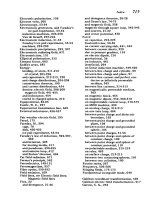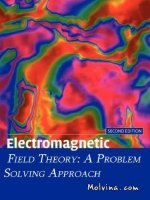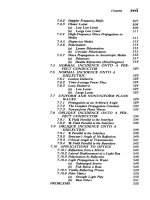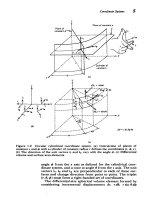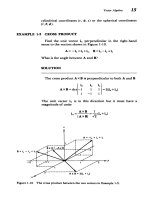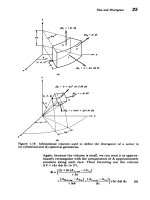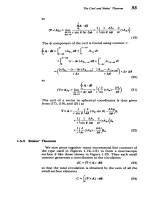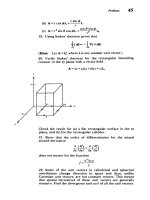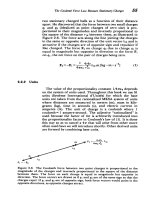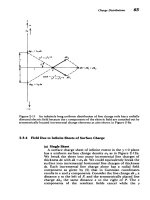Electromagnetic Field Theory: A Problem Solving Approach Part 73 docx
Bạn đang xem bản rút gọn của tài liệu. Xem và tải ngay bản đầy đủ của tài liệu tại đây (202.99 KB, 10 trang )
Problems
695
which
is
plotted
versus
kL
in
Fig.
9-14.
This
result
can
be
checked
in
the
limit
as
L
becomes
very
small
(kL
<<
1)
since
the
radiation
resistance
should
approach
that
of
a
point
dipole
given
in
Section
9-2-5.
In
this
short
dipole
limit
the
bracketed
terms
in
(14)
are
sin
kL
(kL)
2
l
kL
6
lim (kL)
2
(15)
)tL•
i
coS
kL
1
2
kLSi(kL)
-
(kL)
"
so
that
(14)
reduces
to
lim
R
(kL)
2
23L-
2
=
8 0
L(2
L
2
(16)
AL'<
2i
3
3\A
A
Er
which
agrees
with
the
results
in
Section
9-2-5.
Note
that
for
large dipoles
(kL
>>
1),
the
sine
integral
term
dominates
with
Si(kL)
approaching
a
constant
value
of
7r/2
so
that
lim
R
-7kL=
60
•-
r
2
(17)
kL>1
4
Er
A
PROBLEMS
Section
9-1
1.
We wish
to
find
the
properties
of
waves
propagating
within
a
linear
dielectric
medium
that
also
has
an
Ohmic
conductivity
or.
(a)
What
are
Maxwell's
equations
in
this
medium?
(b)
Defining
vector
and
scalar
potentials,
what
gauge
condition
decouples
these
potentials?
(c)
A
point
charge
at
r
=
0
varies
sinusoidally
with
time
as
Q(t)
= Re
((
e'").
What
is
the
scalar
potential?
(d)
Repeat
(a)-(c)
for
waves
in
a
plasma
medium
with
constitutive
law
=
w
eE
at
2.
An
infinite
current
sheet
at
z
=
0
varies
as
Re
[K
0
e
(
'
-
k"-)ix].
(a)
Find
the
vector
and
scalar
potentials.
(b)
What
are
the
electric
and
magnetic
fields?
696
Radiation
(c)
Repeat
(a)
and
(b)
if
the
current
is
uniformly
dis-
tributed
over
a
planar
slab
of
thickness
2a:
jo
eij(9-kXi,
,
-a<z<a
J 0,
Izj
>a
3.
A
sphere
of
radius
R
has
a
uniform
surface
charge
dis-
tribution
oy=
Re
(&o
e"•'
)
where
the
time
varying
surface
charge
is
due
to
a
purely radial
conduction
current.
(a)
Find
the
scalar
and
vector
potentials,
inside
and
outside
the
sphere.
(Hint:
rep=r
2
+R
2
-2rR
cos
0;
rQp
drQ=
rR
sin
0
dO.)
(b)
What
are
the
electric
and
magnetic
fields
everywhere?
Section
9.2
4.
Find
the
effective
lengths,
radiation
resistances
and
line
charge
distributions
for
each
of
the
following
current
dis-
tributions
valid
for
I
zI
<dl/2
on
a
point
electric
dipole
with
short
length
dl:
(a)
I(z)
= Io
cos
az
(b)
f(z)
=
Io
e
-
*1
1
(c)
I(z)=
Io
cosh
az
5.
What
is
the
time-average
power
density,
total
time-average
power,
and
radiation
resistance
of
a
point
magnetic
dipole?
6.
A
plane
wave
electric
field
Re
(Eo
e
i
'
)
is
incident
upon
a
perfectly
conducting
spherical
particle
of
radius
R
that
is
much
smaller
than
the
wavelength.
(a)
What
is
the
induced
dipole
moment?
(Hint:
See
Section
4-4-3.)
(b)
If
the
small
particle
is,
instead,
a
pure
lossless
dielectric
with
permittivity
e,
what
is
the
induced
dipole
moment?
(c)
For both
of
these
cases,
what
is
the
time-average
scat-
tered
power?
7. A
plane
wave
magnetic
field
Re
(Ho
e••)
is
incident
upon
a
perfectly
conducting
particle
that
is
much
smaller
than
the
wavelength.
(a)
What
is
the induced
magnetic
dipole
moment?
(Hint:
See
Section
5-7-2ii
and
5-5-1.)
(b)
What.
are
the
re-radiated
electric
and
magnetic
fields?
(c)
What
is
the
time-average
scattered
power? How
does
it
vary
with
frequency?
8.
(a)
For
the
magnetic
dipole,
how
are
the
magnetic
field
lines
related
to
the
vector
potential
A?
(b)
What
is
the
equation
of these
field
lines?
Section
9.3
9.
Two
aligned
dipoles
if
dl
and
i2
dl
are
placed
along
the
z
axis
a
distance 2a
apart.
The
dipoles
have
the
same
length
i · I
Problems
697
y
while
the
currents
have
equal
magnitudes
but
phase
difference
X.
(a)
What
are the
far
electric
and
magnetic
fields?
(b)
What
is
the
time-average
power density?
(c)
At
what angles
is
the
power
density zero
or
maximum?
(d)
For
2a
=
A/2,
what
values
of
X
give
a
broadside
or
end-fire
array?
(e)
Repeat
(a)-(c)
for
2N+
1
equally spaced
aligned dipoles
along the
z
axis
with
incremental
phase
difference
Xo.
10.
Three
dipoles
of
equal
length
dl
are
placed
along
the
z
axis.
(a)
Find
the far
electric
and
magnetic
fields.
(b)
What
is
the
time
average
power density?
(c)
For
each
of
the
following
cases
find
the
angles
where
the power
density
is
zero
or
maximum.
(i)
=
Io,
12=
21o
(ii)
1
=
I
,
Il2=
-21o
(iii)
Is
=
-Is
=
Io,
12
=
2jIo
2ar
'I
I
1
A
di
I
dl'
li
di
ýp
Y
698
y
(a)
Find
the far
fields
from
this
current
sheet.
(b)
At
what
angles
is
the
power
density
minimum
or
maximum?
Section
9.4
12.
Find
the
far
fields
and
time-average
power
density
for
each
of
the
following
current
distributions
on
a
long
dipole:
(a)
i(z)
Io
( 1
-
2z
/
L),
O<z<L/2
SIo(1+2z/L),
-L/2<z<0
Hint:
C e
az
Z
eaz
dz
=
-(az
- 1)
f
a
(b)
I(z)=
Iocos
1z/L,
-L/2<z
<L/2
Hint:
zi
az
(a
cos
pz
+
p
sin
pz)
e
cos
pz
dz
=
e
(a2+
p2)
(c)
For
these
cases
find
the
radiation
resistance
when
kL
<<
1.
Radiation
11.
Many
closely
spaced
point
dipoles
of
length
dl placed
along
the
x
axis
driven
in
phase
approximate
a
z-directed
current
sheet
Re
(Ko
e'"'i)
of
length
L.
_C_
_
__
__
Solutions
to
Selected
Problems
699
SOLUTIONS
TO
SELECTED
PROBLEMS
Chapter
1
1.
Area
= •a
2
3.
(a)
A
+ B =
6ix
-
2i,
-6i,
(b)
A.B=6
(c)
AxB=-14i
+ 12i,-
18i,
5.
(b)
Bi1=
2(-i.
x+2i,-iý),
B,
=
5i
+
i,
- 3i
7.
(a)
A
- B =
-75
(b)
AxB=-100i,
(c)
0 =
126.870
12.
(a)
Vf
=
(az
+
3bx
2
y)i
+
bx
3
i,
+
axi
14.
(a)
V
A=3
17.
(b)
' =
2abc
18.
(a)
VxA=(x-y
2
)ix-yi,-xi.
1
af.
+
af
1I
af.
h.
au
h,
av
h,
a-w
(c)
dV
=
h/h,h,
du
dv
dw
1 8 a
(d)
VA-A=
-
(h,h.Au)+
(huhA)+
(huhAw)
huhh,
au
av
aw
1
8a(hA4)
8(hA,)
(V
x
A),
=
[ a-hAw)
a(A
hh,
av
aw
25.
(a)
rQp
=
i,
(b)
iQ=
rQ
i
-
5i,
+
2i
rQP
-30
5i.
+
iy
(c)n
-+
Chapter
2
4
wR'pg
3.
Eo
=
4
3
q
4.
Q2=
2reod
Mg
4.
Q•,=
5.
(a)
o
QIQ2
'1/2
L47eR
E
m
700
Solutions
to
Selected
Problems
mlm
2
7.
(a)
m
-
(b)
2
1
1
(b)
v
=
+
2
2-eom
r
ro)
r
/2/2
(d)
t
=
ro
L
J
qEoL
2
8.
h
=
2
mv
6V3
10.
(b)
q
=-
Q
12.
(a)
q
=
2Aoa,
(b)
q
=
irpoa
,
(c)
q
=
2ooabr
15.
0
=
tan
-
1
2
EoMg]
AL
16.
(a)
E,=
2reor
27reo
L
2+X2)
2
18.
(a)
E,=
-Xoa
2
7r
Eo[Z2
+
a2]
3
/
2
a
++Z2
(b)
E
-
+
In
Aoa
2
20.
(a)
E,
-
7ro(a22
23/
21.
E
=
o(a2
23/2
27reo(a
+z )
22.
(a)
QT=
4rEOAR
4
23.
(c)
Po
(-d
2
)
2
<d
E,,=
2Eod
0
Jxl>d
25.
(c)
Por
2
r<a
3eoa
E,
=
2
poa
r>a
3eor>a
pod.
26.
E
=
1
2EO
2
27.
W=-
A
4Eo
Solutions
to
Selected
Problems
28.
(a)
vo-
,•
Q
(b)
r
=
4R
2rEsoRm'
29.
(a)
E=-2Axi.,
pf=
-2Aeo
31.
(a)
Av
=oa
5o
Q
32.
(a)
dq= dz'
R
33.
(c)
V
oa
cos0,
(d)
r
=rosin
0
4reor
qV,
34.
(d)
q
-
V,
36.
(a)
E,-
2
InrE
-
21qeoq
38.
(a)
xo=
q6oEo'
(b)
vo>
Itýq
o/4
(c)
W=
161reod
43.
(e)
A=
,
a
=
R
2
2
44.
(g)
qT=
-
4
7
r
oR
-
Chapter
3
2.
(a)
p
=
AoL
2
,
(e)
p.
=QR
3Q
4.
(a)
po
=
R-
41rvoR
Eo
7.
(a)
d=
Q
Q
8.
(b)
-=2
rEoEo
L
R
S
10.
(a)
Pind=PD
Vo
sinhx/ld
12.
(a)
V(x)
=
2
sinhl/ld
2
sinhl/1d
mmRAo"
15.
(b)
Q
=
q
701
702
Solutions
to
Selected
Problems
A
17.
(a)
Dr
-
27rr
A(e
2
-E1)
2E
2
A
19.
(a)
A'=-A
"
= (
e -
E l) ,
A'=
12E
el+e2
e1+82
23.
(a)
Por
r<R
EoR
E,=
0
r>R
02
s
In-
26.
(a)
R
=
ID(o
2
-
l)
31.
C=
2rl(e
2
a
-elb)
e£a
(b
-a)
In
82
elb
33.
oa(r=al)=-a(
1
-e
);
T=
Ie/
3a,
35.
pf=po
e-ar/(3sA)
Vo
sinh
V2RG(z
-
1)
38.
(a)
v(z)=
sinh
NRl
41.
(b)
2e[E()
- E
2
(O)]
+ ed
=
J(t)l
2
dt
V
o
/l
212
(c)
E(1))
T
21(1-e
- 2
)
It
Vo'
Vo
1
212
Vo
\P
I
42.
(c)
E?=
Vo
=
I
Ro-R)
2reel
43.
(a)
W=-
p2- E
2P
44.
W
=
12ER
47.
(a)
W=
8weoR
48.
(a)
Wi.i,
= 2C V
o,
(b) W 4na=
0CVo
49.
(b)
W=-pE(cos0-1)
50.
h
= 2(e
-
Eo)
2
P.Ks
_I
Solutions
to
Selected
Problems
703
1
roA
+Pod
2
52.
(b)
f
=-
(s
+ d
V
•
o
•
2
(s+d)Lso
TV
0
54.
(b)
f =
( -
eo)
In
-
a
1
Eod
v
55.
V
2 s
1 ,
2
dC
-NVTR'eo
56.
(c)
T =
-v -d
2
dO
s
o'Uwt
57.
(a)
v(t)=
-
41reoR
58.
(a)
p,=
Po
e-o'lU
1
2
nCi
1
3
nCi
59.
(a)
nCi> +
(c)
>
-,
wo
-
R
RL
2
R
2
C
Chapter
4
2.
(a)
(oo
_ >
cos
aye
x> 0
2Ea
V=
2
cos
aye
x
<O
2ea
s
nry
nr(I
-x)
sin
sinh
4.
(a)
V =
1
d
"r
n=1
.HTI
n
odd
n
sinh
d
Po
7.
(a)
V,=
2
sin
ax
e
0
a
12.
P
2
-P
Ercos
0-5
2eo
V(r',
)=
[_-Eor_+
cos4
r>a
2eor
13.
(a)
E=
Eo
1
+
L)
cos
+
t)
-Eo
-)
sin
i
S(
ar
21er r
r
A
(t)
(b)
cos
4
<
taE
(c)
Amax=47reaEo
41TeaEo'
V
In
r
I
In
a
15.
(a)
V(r,
z)
a
Voz
17.
(b)
Eo
-
8p
R
27E
22.
V(2,
2)
=
V(3,
2)
=
V(2,
3)
=
V(3,
3)
=
-4.
23.
(a)
V(2,
2)=
-1.0000,
V(3,
2)=
5000,
V(2,
3)
=
5000,
V(3,
3)
=
.0000
(b) V(2,
2)
=
1.2500,
V(3,
2)
=
2500,
V(2,
3)
=.2500,
V(3,
3)=
-1.2500
Chapter
5
2.
(b)
B
>2mV
es
(e)
-mg
3.
Bo=
-mg
qvo
eE_
4.
(d)
e=
E,
2
m
RBo
8.
(c)
J
=
o(E+vx
B)
2lAol(a
2
+
b)1/2
10.
(a)
B.
=
b
Mrab
B2>
8b2mVo
e(b
-
a
2
)
2
(c)
B.
=
tan
-
2va
n
PoKolr
12.
(a)
B.
-
4
clolL
13.
(a)
B#
I
/olod
15.
(b)
B,=
jod
2
,-o-a
•
a)
lyl
<a
17.
(b)
B=.
2a
0
0
lyl>
Yo
18.
(d)
y
=
at
x
=
-o
21.
(a)
m,
=
qwaa
704
Solutions
to
Selected
Problems
I
_
